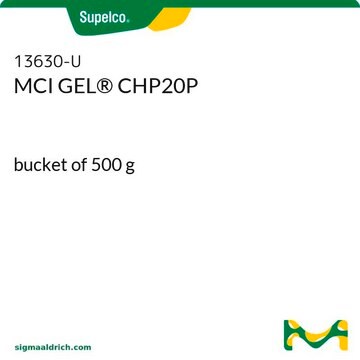13623-U
Sepabeads® SP-207 Polymeric Adsorbent
20-60 mesh, bucket of 1000 g
Anmeldenzur Ansicht organisationsspezifischer und vertraglich vereinbarter Preise
Alle Fotos(1)
About This Item
Empfohlene Produkte
product name
Sepabeads® SP-207, bucket of 1000 g
Form
solid
Qualitätsniveau
Verpackung
bucket of 1000 g
Methode(n)
LPLC: suitable
Oberflächenbereich
650 m2/g
Matrix
brominated styrene-divinylbenzene
Aktive Matrixgruppe
polymer
Partikelgröße
20-60 mesh
Porengröße
~1.20 mL/g pore volume
105 Å mean pore size
Dichte
1.18 g/mL at 25 °C (true wet)(lit.)
Trenntechnik
reversed phase
Verwandte Kategorien
Allgemeine Beschreibung
Sepabeads® SP-207 is a nonionic polystyrene-divinylbenzene polymer resin used as column packing material. It is widely used as a adsorbent for purification in biopharmaceutical applications.
Anwendung
- Sepabeads® SP-207 was used in kinetic and thermodynamics investigation for adsorption/desorption behavio of anthocyanin pigments.
- Sepabeads® SP-207 was used as column packing material for purification of phenolic fraction.
Dichtes Harz für die Anreicherung von hydrophoben Verbindungen aus dicken Fermentationslösungen. Die Bromierung schafft Vorteile gegenüber den Styrol/Divinylbenzol-Harzen: stark hydrophob, hohe Dichte, große Kapazität. Besonders nützlich in Anwendungen mit Fluß von unten nach oben.
Sonstige Hinweise
Quellen in Toluol: 18 %
Rechtliche Hinweise
Diaion is a registered trademark of Mitsubishi Chemical Corp.
Sepabeads is a registered trademark of Mitsubishi Chemical Corp.
Lagerklassenschlüssel
11 - Combustible Solids
WGK
WGK 3
Flammpunkt (°F)
Not applicable
Flammpunkt (°C)
Not applicable
Persönliche Schutzausrüstung
Eyeshields, Gloves, type N95 (US)
Hier finden Sie alle aktuellen Versionen:
Besitzen Sie dieses Produkt bereits?
In der Dokumentenbibliothek finden Sie die Dokumentation zu den Produkten, die Sie kürzlich erworben haben.
Kunden haben sich ebenfalls angesehen
An optimal extraction solvent and purification adsorbent to produce anthocyanins from black rice (Oryza sativa cv. Heugjinjubyeo).
Kang, You Jin, Seung Won Jung, and Seung Ju Lee.
Food Technology and Biotechnology, 23, 97-106 (2014)
Irena Palíková et al.
Journal of agricultural and food chemistry, 57(15), 6584-6589 (2009-07-04)
The effect of Lonicera caerulea L. (blue honeysuckle) phenolic fraction (18.5% anthocyanins) on cell viability and against oxidative damage in low density lipoproteins (oxLDL), in rat microsomes and in primary cultures of rat hepatocytes and human umbilical vein endothelial cells
Renáta Myjavcová et al.
Journal of chromatography. A, 1217(51), 7932-7941 (2010-11-30)
Anthocyanins from the fruit Lonicera caerulea L. var. kamtschatica (blueberry honeysuckle, Caprifoliaceae) were studied via (semi)preparative chromatographic fractionation followed by MS and μLC/MS analysis. The extraction procedure was optimized with respect to analytical purposes as well as its potential use
Unser Team von Wissenschaftlern verfügt über Erfahrung in allen Forschungsbereichen einschließlich Life Science, Materialwissenschaften, chemischer Synthese, Chromatographie, Analytik und vielen mehr..
Setzen Sie sich mit dem technischen Dienst in Verbindung.







